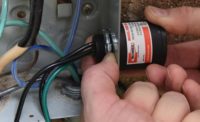Profits And Protection: The Benefits Of Surge Protection
As the brownouts and blackouts in California suggest - and the major blackout in the northeast portion of the United States last year attests - the electrical grid is not highly reliable at this time. Utility reports note that power quality is at its lowest in history and it's getting worse. The utilities thus recommend protection against power quality problems.

Why Surge Protection?
Each home experiences 300-plus potentially damaging electrical surges per year. Home appliances and HVAC equipment, which depend on electronics, are sensitive to these surges. These units are a costly investment for the homeowner, and there typically is no protection.A surge is a high-amplitude, short-duration electrical fluctuation that can cause harm to electrical, electromechanical, and electronic equipment. Surges are caused by lightning, utility events, and internal events:
- Pumps (well or pool);
- A/C condenser motors;
- Refrigeration motors;
- Dishwasher motors; and
- Washer/dryer motors.
These events can result in the three D's of surge problems: degradation (of equipment components), destruction, and downtime.
Surge Solutions
Surge protectors provide protection against:A surge protector works by shunting the voltage surge to ground. A good ground is imperative. The National Electrical Code (NEC) maximum resistance at ground is 25 ohms.
Contractor Benefits In Providing Surge Solutions
By informing your customers of the potential damage of an electrical surge, and the solution you can provide, you differentiate your contracting company from the competition and identify it as a quality service company concerned about the long-term operation of their equipment. This can result not only in the sale of a surge protector, but also repeat customers, referral business, and increased profits.For a five truck contracting company that does five calls per day, there are 25 opportunities to offer a surge solution. If you close 40 percent of those offers, you sell 10 surge protector units. With a price of $100 installed and your cost at $25, you earn $75 of revenue for each sale, which equals a total of $750 more revenue per day. With 240 workdays per year, that equals $180,000 in add-on equipment revenue.
Homeowner Benefits From A Surge Solution
The homeowner benefits from surge protection because it provides inexpensive insurance for a central air conditioning system. After the home and car, air conditioning systems are the most costly item to repair or replace. Homeowners carry insurance on their home and car. What about for their central air system?By getting this protection from an HVAC contractor, they get professional installation and reliable operation. In addition, some surge solutions handle up to 100,000 amps of surge current, offer a lifetime warranty, and include a $1,000 connected equipment warranty.
As the sidebar below indicates, installing a surge protector is not complicated and can be readily accomplished by a technician. The tech can advise the customer of the potential problem and solution, and provide a custom flyer on the subject. After other service work is done, the customer can decide yes or no. If yes, install. If no, ask them to sign an acknowledgement and refusal form.
Many of your customers already have surge protection for their personal computers. With the proven instability of the national electrical grid, the addition of surge protection for an HVAC system is a logical, low-cost solution for the customer that helps keep their equipment up and running, and also benefits the contractor.
Sidebar: Installation Instructions
A/C disconnect installation for HVAC applications: Although the surge protector can be installed at the main breaker panel, SUPCO recommends installation at the service disconnect for the A/C condensing unit. The surge arrestor is a simple three-wire installation:1. Turn off the main power to the service disconnect and meter test for safety.
2. Remove a knockout from the disconnect.
3. Remove the retaining ring from the nipple on the surge protector.
4. Feed the nipple and wire into the service disconnect.
5. Re-secure with the retaining ring.
6. Route the green wire to the grounding lug and secure.
7. Securely "piggyback" the two black wires to the disconnect power terminals.
8. Replace cover on disconnect.

Electrical panel installation:
1. Turn off main breaker
2. Remove the front cover from the panel.
3. Remove 3/4-inch knockout on side of panel box.
4. Mount unit through the knockout to the side of the panel.
5. Secure green wire to the grounding bus.
6. Connect the black wires to the load side of the closest two pole breaker.
7. Connected wiring must be kept short.
8. Replace front cover of panel box.

Installation Tips:
1. Never sharply bend the surge protector wires during termination. Offer the surge as straight a pathway to ground as possible.
2. Always keep the surge protector wires as short as possible to increase the effectiveness and response time of the unit.
3. Always keep the protector at least 3 feet from the equipment that you want to protect. This allows response time for the protector to do its job before the transient gets to the protected equipment.
Gary Lampasona is vice president, marketing (as well as an engineer) at Sealed Units Parts Co. Inc. (SUPCO), Allenwood, N.J. For more information, e-mail glampasona@supco.com or visit www.supco.com. Contractors can obtain a surge protection marketing kit from SUPCO by e-mailing Lampasona.
Publication date: 03/22/2004








